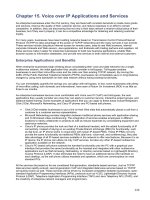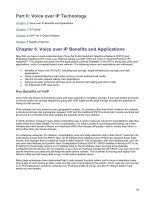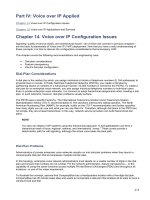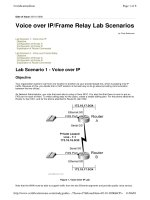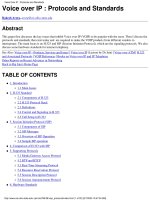Configuring cisco voice over IP second edition
Bạn đang xem bản rút gọn của tài liệu. Xem và tải ngay bản đầy đủ của tài liệu tại đây (8.7 MB, 578 trang )
228_VoIP2e_FM.qxd
8/14/02
4:29 PM
Page i
With more than 1,500,000 copies of our MCSE, MCSD, CompTIA, and Cisco
study guides in print, we continue to look for ways we can better serve the
information needs of our readers. One way we do that is by listening.
Readers like yourself have been telling us they want an Internet-based service that would extend and enhance the value of our books. Based on
reader feedback and our own strategic plan, we have created a Web site
that we hope will exceed your expectations.
is an interactive treasure trove of useful information focusing on our book topics and related technologies. The site
offers the following features:
■
One-year warranty against content obsolescence due to vendor
product upgrades. You can access online updates for any affected
chapters.
■
“Ask the Author” customer query forms that enable you to post
questions to our authors and editors.
■
Exclusive monthly mailings in which our experts provide answers to
reader queries and clear explanations of complex material.
■
Regularly updated links to sites specially selected by our editors for
readers desiring additional reliable information on key topics.
Best of all, the book you’re now holding is your key to this amazing site.
Just go to www.syngress.com/solutions, and keep this book handy when
you register to verify your purchase.
Thank you for giving us the opportunity to serve your needs. And be sure
to let us know if there’s anything else we can do to help you get the
maximum value from your investment. We’re listening.
www.syngress.com/solutions
228_VoIP2e_FM.qxd
8/14/02
4:29 PM
Page ii
228_VoIP2e_FM.qxd
8/14/02
4:29 PM
Page iii
1 YEAR UPGRADE
BUYER PROTECTION PLAN
Configuring Cisco
Voice
Over
Paul J. Fong
Eric Knipp
David Gray
Scott M. Harris
Larry Keefer, Jr.
Charles Riley
Stuart Ruwet
Robert Thorstensen
Vincent Tillirson
Michael E. Flannagan
Jason Sinclair
Technical Reveiwer
Technical Editor
IP
Second Edition
228_VoIP2e_FM.qxd
8/14/02
4:29 PM
Page iv
Syngress Publishing, Inc., the author(s), and any person or firm involved in the writing, editing, or
production (collectively “Makers”) of this book (“the Work”) do not guarantee or warrant the results
to be obtained from the Work.
There is no guarantee of any kind, expressed or implied, regarding the Work or its contents.The Work
is sold AS IS and WITHOUT WARRANTY. You may have other legal rights, which vary from state
to state.
In no event will Makers be liable to you for damages, including any loss of profits, lost savings, or
other incidental or consequential damages arising out from the Work or its contents. Because some
states do not allow the exclusion or limitation of liability for consequential or incidental damages, the
above limitation may not apply to you.
You should always use reasonable care, including backup and other appropriate precautions, when
working with computers, networks, data, and files.
Syngress Media®, Syngress®,“Career Advancement Through Skill Enhancement®,” “Hack Proofing®,”
and “Ask the Author UPDATE®,” are registered trademarks of Syngress Publishing, Inc. “Mission
Critical™,” and “The Only Way to Stop a Hacker is to Think Like One™” are trademarks of Syngress
Publishing, Inc. Brands and product names mentioned in this book are trademarks or service marks of
their respective companies.
KEY
001
002
003
004
005
006
007
008
009
010
SERIAL NUMBER
8TPK9H7GYV
H8UN7W6CVF
439HF5TS3A
Z2B76Z2N9Y
UT5R39SC4E
X6BUMP7NS6
4EPQ2AKG6R
9BKG8DM5D7
SW4KFAUPFH
5BVM39ZCV6
PUBLISHED BY
Syngress Publishing, Inc.
800 Hingham Street
Rockland, MA 02370
Configuring Cisco Voice Over IP, Second Edition
Copyright © 2002 by Syngress Publishing, Inc. All rights reserved. Printed in the United States of
America. Except as permitted under the Copyright Act of 1976, no part of this publication may be
reproduced or distributed in any form or by any means, or stored in a database or retrieval system,
without the prior written permission of the publisher, with the exception that the program listings
may be entered, stored, and executed in a computer system, but they may not be reproduced for
publication.
Printed in the United States of America
1 2 3 4 5 6 7 8 9 0
ISBN: 1-931836-64-7
Technical Editor: Jason Sinclair
Cover Designer: Michael Kavish
Technical Reviewer: Michael E. Flannagan
Page Layout and Art by: Shannon Tozier
Acquisitions Editor: Catherine B. Nolan
Copy Editor: Darlene Bordwell
Developmental Editor: Jonathan Babcock
Indexer: Nara Wood
Distributed by Publishers Group West in the United States and Jaguar Book Group in Canada.
228_VoIP2e_FM.qxd
8/14/02
4:29 PM
Page v
Acknowledgments
We would like to acknowledge the following people for their kindness and support
in making this book possible.
Ralph Troupe, Rhonda St. John, Emlyn Rhodes, and the team at Callisma for their
invaluable insight into the challenges of designing, deploying and supporting worldclass enterprise networks.
Karen Cross, Lance Tilford, Meaghan Cunningham, Kim Wylie, Harry Kirchner, Kevin
Votel, Kent Anderson, Frida Yara, Jon Mayes, John Mesjak, Peg O’Donnell, Sandra
Patterson, Betty Redmond, Roy Remer, Ron Shapiro, Patricia Kelly, Andrea Tetrick,
Jennifer Pascal, Doug Reil, David Dahl, Janis Carpenter, and Susan Fryer of Publishers
Group West for sharing their incredible marketing experience and expertise.
Jacquie Shanahan, AnnHelen Lindeholm, David Burton, Febea Marinetti, and Rosie
Moss of Elsevier Science for making certain that our vision remains worldwide in
scope.
David Buckland,Wendi Wong, Marie Chieng, Lucy Chong, Leslie Lim, Audrey Gan,
and Joseph Chan of Transquest Publishers for the enthusiasm with which they receive
our books.
Kwon Sung June at Acorn Publishing for his support.
Jackie Gross, Gayle Voycey, Alexia Penny, Anik Robitaille, Craig Siddall, Darlene
Morrow, Iolanda Miller, Jane Mackay, and Marie Skelly at Jackie Gross & Associates
for all their help and enthusiasm representing our product in Canada.
Lois Fraser, Connie McMenemy, Shannon Russell, and the rest of the great folks at
Jaguar Book Group for their help with distribution of Syngress books in Canada.
A special welcome to the folks at Woodslane in Australia! Thank you to David Scott
and everyone there as we start selling Syngress titles through Woodslane in Australia,
New Zealand, Papua New Guinea, Fiji Tonga, Solomon Islands, and the Cook Islands.
v
228_VoIP2e_FM.qxd
8/14/02
4:29 PM
Page vi
Contributors
Sam Cushway is a Senior Consultant with Callisma where he designs
and implements routing and switching solutions for several of Callisma’s
clients. His specialties include Cisco hardware, strategic network planning,
network architecture and design, and network troubleshooting and optimization. Sam has 12 years of experience in data communications and his
background includes positions as a Senior Network Engineer at TCI
Cable and WorldCom. Sam is a CCIE candidate with a focus on internetworking and convergence.
Paul J. Fong (CCNP, CCDP) holds a bachelor’s and master’s degree
from Stanford University.While pursuing his studies, Paul developed
speech recognition software at the Xerox Palo Alto Research Center and
published his work in IEEE Transactions on Systems, Man and Cybernetics.
His background includes positions as an Advisory Systems Analyst at IBM
where he developed a network monitoring system for NASA Space
Shuttle telemetry, and as a Senior Member of the Technical Staff at MCI
where he played a key role in the development of the SRDF-over-IP
protocol. He is also a contributor to Configuring IPv6 for Cisco IOS
(Syngress Publishing, ISBN: 1-928994-84-9). Paul is a member of the
Colorado Springs Cisco Users Group and lives in Monument, CO with
his wife, Sharon, and their daughter, Shana.
David Gray (CCNA, CCDA, CCNA-WAN Switching, MCSE, ASE,
Brocade Fabric Professional) is a Consultant with Callisma. David
specializes in IP telephony and convergence, Active Directory design and
implementation, storage area networking, service provider networks to
include optical design and implementation. David’s background includes
positions as a Senior Project Engineer for WorldCom, an engineer for
Digital Equipment Corporation/Compaq, and as an analyst for a variety
of other firms.
vi
228_VoIP2e_FM.qxd
8/14/02
4:29 PM
Page vii
Scott M. Harris (CCDP, CCNP, MCNE) is a Senior Consultant with
Callisma with a focus on internetworking and data/voice/video integration. His background includes 14 years of network experience in small,
medium, and large network infrastructures. He currently provides business
consultation on the planning, design, implementation, and Day Two support of Cisco AVVID. He has worked with a variety of public and private
sector businesses and government institutions on switched LAN and
WAN design, implementation, support, and training.
Larry Keefer, Jr. (CCNP, CCDP, MCSE, MCP+I, MCNE, CNE-3,
CNE-4, CNE-5, CNE-GW, BCFP, BCSD) is a Senior Consultant with
Callisma in Atlanta, GA. He currently provides senior-level strategic and
technical consulting to Callisma clients throughout the United States. His
specialties include Cisco routers and LAN switches, Microsoft Windows
NT/2000, Novell NDS, IP telephony, storage area network (SAN) planning, design, implementation, and support for large enterprise organizations. Larry is a contributing author for Syngress Publishing’s Cisco
AVVID & IP Telephony Design and Implementation (ISBN: 1-928994-83-0).
Larry’s background includes a position as a Senior Network Engineer/
Team Leader at Rush Creek Solutions (formerly BPI) for enterprise and
government organizations in the Rocky Mountain region. Larry holds a
bachelor’s of Science degree from Illinois Status University and has completed coursework towards a master’s degree in Information Systems from
the University of Phoenix. Larry currently resides in Woodstock, GA with
his family, Carol, Kayla, and Kristin.
Eric Knipp (CCNP, CCDP, CCNA, CCDA, CIPT, CUSE, MCSE-2000,
MCSE, MCP+I) is a Consultant with Callisma. Eric specializes in IP telephony and convergence, Cisco routers, LAN switches, Active Directory
design and implementation, and network design and implementation. He
has passed both the CCIE Routing and Switching written exam as well
as the CCIE Communications and Services Optical qualification exam.
Eric is currently preparing to take the CCIE lab later this year. Eric’s
background includes positions as a Project Manager for a major international law firm and as a Project Manager for Nortel. Eric is also a contributing author to Cisco AVVID & IP Telephony Design and Implementation
vii
228_VoIP2e_FM.qxd
8/14/02
4:29 PM
Page viii
(Syngress Publishing, ISBN: 1-928994-83-0), Managing Cisco Network
Security, Second Edition (Syngress Publishing, ISBN: 1-931836-56-6), and
Configuring IPv6 for Cisco IOS (Syngress Publishing, ISBN: 1-928994-84-9).
Estevan Macias (CCIE#5236, CCNA, CCDA, CCNP, CCDP, CIPT,
CSS1, CCIE WAN Switching, MCSE, MCP+I) is a Senior Consultant
with Callisma. He currently provides senior-level strategic and technical
consulting to all Callisma clients in the western region of the United
States. His specialties include Cisco routers and LAN switches, ATM
WAN switches, security, design and implementation, strategic network
planning, network architecture and design, and network troubleshooting
and optimization. Estevan’s background includes positions as a Senior
Engineer at Timebridge Technologies, and as a Network Engineer at
Convergent Communications in the professional services division. Estevan
holds a master’s of Science in Telecommunications from the University of
Denver, and a bachelor’s of Science in Computer Networking from Regis
University.
Charles Riley (CCNP, CSS1, CISSP, CCSA, MCSE, CNE-3) is a
Network Engineer with a long tenure in the networking and security
fields. Charles is the author of the CCNP Routing Study Guide (Osborne
McGraw Hill). He has designed and implemented robust networking
solutions for several Fortune 500 companies. He started with the U.S.
Army at Fort Huachuca, AZ, eventually finishing his Army stretch as
the Network Manager of the Seventh Army Training Command in
Grafenwoehr, Germany. As a consultant for Sprint in Kansas, Charles
developed and managed solutions involving data center design, network
migration, storage technologies, and numerous IP routing and transport
enterprises for many different customers. Charles holds a bachelor’s
degree from the University of Central Florida. He is fortunate to have the
love and encouragement of his wife, René, and his daughter,Tess, who
make life so wonderful.
viii
228_VoIP2e_FM.qxd
8/14/02
4:29 PM
Page ix
Stuart Ruwet (CCNP–WAN Switching, HPOV Certified Consultant,
SNIA Level 1) is a Consultant with Callisma. Stuart is a Cisco/StrataCom
WAN specialist with broad experience in the telecommunications
industry. He has worked with a wide variety of networking technologies
and platforms including multiple transmission protocols, and network
management systems with an emphasis in ATM and IP. Prior to working
with Callisma, Stuart served as a Senior Network Engineer and Manager
of Network Engineering for Convergent Communications, where he was
responsible for designing and building a nation-wide ATM network.
Stuart holds a bachelor’s degree in International Business from the
University of Denver. He currently lives in Castle Rock, CO with his
wife, Meghan, and daughter, Kyla.
Robert Thorstensen (CCNA, CCNA–WAN, CCDA, CCNP, CCDP,
CCIP, CSS1, CIPT, BCFP) is a Consultant with Callisma in Denver, CO
and has five years experience in the networking industry. Robert has
extensive experience with a wide variety of internetworking and optical
technologies, protocols, and hardware platforms, with an emphasis on IP
telephony, routing, switching, security, and optical networking. Robert’s
background includes positions as a second tier NOC Engineer at
Rhythms NetConnections, and as a Network Engineer at Internet
Communications Corporation. Robert would like to thank his wife, Lisa,
and his three daughters, Brittany, Alyssa, and Aimee, for their patience and
understanding on the numerous nights and weekends they would rather
have been outside at the park instead of “tip-toeing” around the house.
Vincent Brian Tillirson is a Consultant with Callisma.Vincent is
currently providing technical consulting to a large enterprise banking
company in Atlanta, GA. His specialties are in WAN/LAN design, implementation and voice deployments.Vincent has participated in the design
and implementation of voice and data networks across the United States,
Europe and South America.Vincent holds a bachelor’s of Science degree
in Computer Science from North Georgia College and University.
ix
228_VoIP2e_FM.qxd
8/14/02
4:29 PM
Page x
Technical Editor
Jason Sinclair (CCIE #9100, CCNP, CCNA) is the Manager of the
Network Control Center at PowerTel Ltd., which is Australia’s third
largest telecommunications carrier. Jason is responsible for all operational
aspects of the PowerTel voice, data and IP networks. Jason’s technical
background is predominantly in large scale IP, Internet,VoIP and DLSW
networking. He has also designed and deployed several large-scale networks that have made extensive use of BGP and MPLS technology.
Previously Jason has worked for a number of ISP’s and carriers in the Asia
Pacific Region. Jason specializes in IP and IPX routing protocols, with
particular focus on BGP, OSPF and ISIS. He is also an expert in IBM
networking, ATM, Frame Relay, ISDN,Token Ring, and Ethernet. Jason
has published an article for Certification Zone, which is a CCIE level discussion of the theory and configuration of EIGRP. He is also working on
articles covering networking case studies, large-scale carrier networks and
IBM Networking. Jason lives in Sydney, Australia with his wife, Michelle,
and son, Andy.
Technical Reviewer
Michael E. Flannagan (CCIE #7651, CCDP, CSA, NNCAS) is a
Network Consulting Engineer and Team Lead in the Advanced Services
Group at Cisco Systems. Mike’s experience includes extensive work with IP
routing protocols and Quality of Service. Prior to joining Cisco Systems, he
held positions as a Global Network Manager for an international corporation, and as a consultant specializing in Quality of Service. Other books
from Syngress Publishing to which Mike has contributed include
Administering Cisco QoS in IP Networks (ISBN: 1-928994-21-0), and Cisco
AVVID & IP Telephony Design and Implementation (ISBN: 1-928994-83-0).
x
228_VoIP2e_toc.qxd
8/14/02
4:30 PM
Page xi
Contents
Foreword
xxvii
Introduction
xxix
Chapter 1 Introduction to Voice Over IP
and Business Justifications
Introduction
Introduction to Voice Over IP
General Overview of Voice Technologies
Today’s VoIP Possibilities
The PBX Reality
The VoIP Bandwagon
Common VoIP Implementation Services
Toll Bypass
VoFR
VoATM
Point-to-Point Links
Cisco IP Telephony
Cisco IP Telephony Clients
IP Softphones
Cisco Call Manager
Gateways
Switches
Corporate Multimedia
Fax
Video
The Emerging Carrier and Intercarrier VoIP
Wholesale Termination
IP Transport
1
2
2
3
3
4
6
6
6
6
7
8
8
8
9
9
9
10
10
10
11
11
11
11
xi
228_VoIP2e_toc.qxd
xii
8/14/02
4:30 PM
Page xii
Contents
Basic Toll-Bypass Designs
Tie-Line Replacement
Where the Money Is
The Merging of Voice and Data Networks
What About Data?
Convergence
The PSTN as a Backup
Using Frame Relay for Toll Bypass
Where to Use VoFR
The Growth Curve of Frame Relay
When Does Frame Relay Make
More Sense?
Using Asynchronous Transfer Mode for
Toll Bypass
Where to Use It
Continuous Bit Rate
QoS versus Availability
Using Point-to-Point Leased Lines for
Toll Bypass
Return on Investment
Reviewing Current Telephony Costs
Designing the New Solution
Building the ROI and Payback Period
Case Study: PBX Replacement with
IP Telephony
Advanced Features and Integration Possibilities
Replacing the Traditional PBX
Call Routing
Dial Plan
Interactive Voice Response
Unified Messaging and the Cisco
Unity System
TAPI Integration
Web Click-to-Talk
Transfer, Forward, and Conference Capabilities
Call Transfer
Call Forward
13
13
13
14
14
15
16
17
18
18
19
21
21
24
25
27
29
29
32
33
34
37
37
38
39
40
41
43
44
45
45
45
228_VoIP2e_toc.qxd
8/14/02
4:30 PM
Page xiii
Contents
Call Park and Call Pickup
Music on Hold
Conferencing
Web Attendant
Call Detail Recording and Data Mining
Call Detail Records
Tracing and Logging
Transcoders
Summary
Solutions Fast Track
Frequently Asked Questions
xiii
46
46
46
46
47
47
48
48
49
51
53
Chapter 2 Traditional Voice Telephony
Principles
57
Introduction
58
Analog Systems
58
Basic Telephone System Operation
59
Analog Network Components
61
Voice Encoding: Standards and Techniques
65
Waveform Encoding
65
Source Encoding
66
Cabling
69
Analog Signaling
73
Analog Signal Composition
73
E&M Signaling
77
Loop and Ground Start
80
Dial-Pulse Signaling
81
Dual-Tone Multifrequency
82
Digital Transmission
85
Time-Division Multiplexing
85
Integrated Services Digital Network Signaling 87
ISDN Reference Points
88
Call Control Signaling
89
Channel Associated Signaling
89
Common Channel Signaling
90
Signaling System 7
90
228_VoIP2e_toc.qxd
xiv
8/14/02
4:30 PM
Page xiv
Contents
Signaling Points
Signaling Links
SS7 Protocol Stack
Analog-to-Digital Conversion
Modems
Factors That Affect V.92 Throughput
Summary
Solutions Fast Track
Frequently Asked Questions
Chapter 3 VoIP Signaling and Voice
Transport Protocols
Introduction
An Overview of IP Networks
IP Addressing Overview
Address Classes
Private Address Space
Subnetting and Supernetting Review
VoIP Signaling, Addressing, and Routing
Signaling Between Routers and PBXs
VoIP Signaling
Introducing H.323
H.323 Components
H.323 Terminals (Endpoints)
H.323 Gateways
H.323 Gatekeepers
Multipoint Control Units
The H.323 Protocol Stack
IP,TCP, and UDP
Internet Protocol
Transmission Control Protocol
User Datagram Protocol
H.225
H.245
Registration, Administration, and Status
Real-Time Transport Protocol
Codecs
91
92
94
97
98
100
102
103
107
109
110
111
114
115
117
118
122
123
124
126
127
128
128
129
130
131
131
131
132
132
132
132
133
133
133
228_VoIP2e_toc.qxd
8/14/02
4:30 PM
Page xv
Contents
H.323 Call Stages
H.323 Discovery and Registration
Device Discovery and Registration
Intrazone Call Placement
Interzone Call Placement
H.323 Call Setup
Logical Channel Setup
Media Stream and Media Control Flows
Call Termination
H.323 Endpoint-to-Endpoint Signaling
Session Initiation Protocol
Key Benefits of Session Initiation Protocol
Session Initiation Protocol Components
Session Initiation Protocol Messages
Media Gateway Control Protocol
MGCP Connections
MeGaCo/H.248
The Role of QoS in Packet-Switched
Voice Networks
What Is Quality of Service?
Applications for Quality of Service
Three Levels of QoS
Why QoS Is Essential in VOIP Networks
Summary
Solutions Fast Track
Frequently Asked Questions
Chapter 4 An Overview of Cisco’s VoIP
Components
Introduction
Exploring the Types of Voice Ports
Foreign Exchange Station Interface
Foreign Exchange Office Interface
E&M Interface
E1/T1 Voice Connectivity
Voice Modules and Cards
Voice Network Modules
xv
134
134
135
135
136
137
139
141
142
143
144
145
146
147
148
149
150
152
153
153
154
157
159
161
165
167
168
168
168
169
170
172
173
173
228_VoIP2e_toc.qxd
xvi
8/14/02
4:30 PM
Page xvi
Contents
Voice Interface Cards
VIC-2E/M
VIC-2FXS
VIC-2FXO
VWIC-2MFT-T1
Two-Port ISDN BRI Card
Four-Port Analog DID/FXS VICs
Connecting VNMs and VICs to the Router
1700 Series Router Configurations
Cisco 1751 Modular Access Router
The Cisco 1760 Modular Access Router
2600, 3600, and 3700 Series Router
Configurations
7200 and 7500 Series Router Configurations
MC3810 Router Configurations
AS5350 and 5850 Universal Gateway
Configuration
Cisco Catalyst 4000 and 6000 Series Switches
Cisco Catalyst 4200
VoIP Terminology
ATM
Bandwidth Consumption
CAC
Call Legs
Codec
Delay
Dial Peers
Dial Plans
Echo
Frame Relay
Gateways and Gatekeepers
H.323
Jitter
MGCP
Number Extension and Digit Translation
PSTN
POTS
176
176
177
177
177
178
178
179
179
179
184
187
195
197
197
200
201
202
202
202
203
203
203
203
203
203
204
204
204
204
204
204
205
205
205
228_VoIP2e_toc.qxd
8/14/02
4:30 PM
Page xvii
Contents
Serialization Delay
SGCP
TDM
VAD
VoATM
VoFR
VoIP
Summary
Solutions Fast Track
Frequently Asked Questions
xvii
205
205
205
206
206
206
206
207
207
209
Chapter 5 VoIP Configurations
211
Introduction
212
Voice Port Cabling and Configuration
212
Port Numbering on the 1700 Series
213
Port Numbering on the 2600 and 3600 Series 214
Port Numbering on the MC3810 Series
215
Port Numbering on the 7200 Series
216
Port Numbering on the AS5x00 Series
216
LED Status
217
Configuring Voice Ports
219
Configuring FXO or FXS Voice Ports
220
Configuring E&M Ports
222
Configuring DID Ports
224
The Connection Command
225
Voice Port-Tuning Commands
226
Concepts of Delay and Echo
226
Fine-Tuning FXS/FXO Ports
229
Fine-Tuning E&M Ports
231
Configuring Dial Plans and Dial Peers
234
Call Legs: POTS versus Voice Network
Dial Peers
236
Creating and Implementing Dial Plans
237
Configuring Dial Peers
239
Number Expansion
246
Direct Inward Dialing
246
228_VoIP2e_toc.qxd
xviii
8/14/02
4:30 PM
Page xviii
Contents
Configuring Trunking
Trunks
Tie Lines
PLAR
PLAR-OPX
Direct Voice Trunking versus Dial-Digit
Interpretation
Standard Dialing Analysis:
Digit Interpretation
Supervisory Disconnect
Wink-Start Signaling versus
Immediate-Start Signaling
Configuring ISDN for Voice
Configuring ISDN BRI Voice Ports
Configuring ISDN PRI Voice Ports
Configuring Q.931 Support
Configuring QSIG
Configuring CAS
Configuring CCS
Configuring T-CCS
Configuring Gateways and Gatekeepers
Configuring H.323 Gateway
Configuring H.323 Gatekeeper
H.323 ID Addresses
Zone Prefixes
Technology Prefixes
Summary
Solutions Fast Track
Frequently Asked Questions
249
249
251
251
252
255
257
258
260
263
264
264
265
266
268
268
269
270
270
271
275
276
279
Chapter 6 Configuring QoS for VoIP
Introduction
QoS Overview
Available QoS Options
Maximizing Bandwidth
Compressed Real-Time Transport Protocol
281
282
282
283
284
285
252
253
253
228_VoIP2e_toc.qxd
8/14/02
4:30 PM
Page xix
Contents
Understanding Real-Time Transport
Protocol
RTP Header Compression
cRTP Implementation
Queuing
Custom Queuing
Priority Queuing
Weighted Fair Queuing
CBWFQ
Priority Queuing with WFQ
Packet Classification
IP Precedence
Policy Routing
Resource Reservation Protocol
Call Admission Control
RTP Priority
Traffic Shaping
Weighted Random Early Detection
Link Fragmentation and Interleaving
VoIP QoS Configuration Examples
Maximizing Bandwidth
Configuring cRTP
Enable cRTP on a Serial Interface
Enable cRTP with Frame Relay
Encapsulation
Change the Number of Header
Compression Connections
Displaying Statistics
CRTP Configuration Examples
Configuring Queuing
Configuring Custom Queuing
Enabling Custom Queuing
Adjusting Byte Counts and Queue Sizes
Applying Your Configuration to
an Interface
Verifying Custom Queuing
xix
285
285
287
287
288
288
289
291
292
292
293
294
294
295
297
298
298
299
300
300
301
301
301
302
302
302
303
304
304
305
306
306
228_VoIP2e_toc.qxd
xx
8/14/02
4:30 PM
Page xx
Contents
Configuring Priority Queuing
Enabling Priority Queuing
Configuring the Queue Limits
Applying Your Priority List to
an Interface
Verifying Priority Queuing
Configuring Weighted Fair Queuing
Enabling Weighted Fair Queuing
Verifying Weighted Fair Queuing
Configuring Class-Based Weighted Fair
Queuing
Defining Class Maps
Creating Policies
Attaching Policies to Interfaces
Verifying CBWFQ
Configuring Packet Classification
IP Precedence
Verifying IP Precedence
Policy Routing
Verifying Policy Routing
Configuring RSVP
Verifying RSVP
Call Admission Control
Verifying Call Admission Control
Configuring Priority Queuing with WFQ
(IP RTP Priority)
Verifying Priority Queuing with WFQ
Configuring Traffic Shaping
Verifying Traffic Shaping
Configuring Congestion Avoidance with
WRED
Verifying WRED
Configuring Link Fragmentation and
Interleaving
Verifying Link Fragmentation and
Interleaving
308
308
309
310
311
312
312
313
314
315
316
318
319
320
321
321
322
322
323
323
325
326
329
330
331
333
333
334
335
336
228_VoIP2e_toc.qxd
8/14/02
4:30 PM
Page xxi
Contents
Summary
Solutions Fast Track
Frequently Asked Questions
xxi
338
339
340
Chapter 7 Testing and
Troubleshooting VoIP
343
Introduction
344
A Basic Troubleshooting Methodology
345
Layer 1 Troubleshooting
346
Troubleshooting Equipment, from Powerup
to Operating State
346
Troubleshooting Cabling
348
Troubleshooting Ports
351
Troubleshooting Other Physical Layer Issues 353
Troubleshooting Private Branch
Exchange Problems
354
Troubleshooting Central Office Problems 355
Troubleshooting Underlying Circuit
and Network Problems
356
Layer 2 Troubleshooting
365
Troubleshooting Serial Interfaces
365
Troubleshooting Frame Relay
367
Troubleshooting Asynchronous Transfer Mode 372
Layer 3 Troubleshooting
375
Troubleshooting IP
376
IP Addressing and Routing
376
IP Quality of Service
377
Queuing
379
Bandwidth Reservation Schemes
381
Resource Reservation Protocol
383
Troubleshooting Dial Plans
384
Troubleshooting Voice Ports
388
Troubleshooting FXS and FXO Voice Ports
388
Troubleshooting E&M Voice Ports
392
Troubleshooting Dial Peers
395
Troubleshooting Signaling Errors
399
FXS/FXO signaling
399
228_VoIP2e_toc.qxd
xxii
8/14/02
4:30 PM
Page xxii
Contents
Loop Start
Ground Start
E&M Signaling
Wiring Schemes
Trunk Seizure
Troubleshooting Gateways and
Gatekeepers
Summary
Solutions Fast Track
Frequently Asked Questions
Chapter 8 Connecting PABXs with
VoIP Scenarios
Introduction
Collecting the Information
Gathering Information for Design Purposes
Compiling the Information
VoIP Corporation’s Tie-Line Replacement
Business Drivers
Key Stakeholders
Hardware
Software
Documentation
Security
Compiling the Information
Business Case:VoIP Tie-Line
Replacement
Designing a Basic Tie-Line Replacement
with VoIP
Basic Design Principles for Tie-Line
Replacement
Designing the Basic Tie-Line Replacement
Configuring a Basic Tie-Line Replacement
with VoIP
Configuration Details for the Basic
Tie-Line Replacement
Atlanta Router
399
400
401
401
402
405
408
410
413
415
416
416
417
420
421
421
422
422
423
423
423
423
424
429
429
432
435
436
436
228_VoIP2e_toc.qxd
8/14/02
4:30 PM
Page xxiii
Contents
New York Router
Chicago Router
Atlanta Router
Atlanta Router
Atlanta Router
Chicago Router
Atlanta Router Configuration
Chicago Router Configuration
New York Router Configuration
Configuring Advanced Trunking Scenarios
Advanced Trunking Options Overview
Configuring Advanced Trunking Options:
Case Studies
Atlanta Router Configuration
Chicago Router Configuration
Atlanta Router Configuration
New York Router Configuration
Integrating Voice and Data
The Rationale for Integrating Voice and
Data Networks
Integrating Voice and Data: Case Studies
Atlanta Router Configuration
Atlanta Router Configuration
Chicago Router Configuration
New York Router Configuration
Verifying and Testing the Solution
Testing and Verification Methodology
Testing the Deployed Solutions
Testing Tie-Line Replacement
Testing Advanced Trunking
Testing Voice and Data Integration
Summary
Solutions Fast Track
Frequently Asked Questions
xxiii
436
436
437
437
438
438
439
442
443
446
446
447
447
448
449
450
451
451
451
453
456
459
461
463
463
464
464
466
467
468
468
471
228_VoIP2e_toc.qxd
xxiv
8/14/02
4:30 PM
Page xxiv
Contents
Chapter 9 Intra- and Interoffice
VoIP Scenarios
Introduction
Creating a Basic Intraoffice Dial Plan
What Is a Dial Plan?
Collecting the Information
Scenario 1
Determining the Requirements
Designing the Dial Plan
Designing a Single-Router VoIP Network
Choosing the Hardware
Creating the Design Plan
Configuring a Single-Router VoIP Network
Reviewing the Design
Configuring the Router: Step by Step
Testing and Verification
Merging the PBX and VoIP Networks
Designing PBX Interconnect Trunks
Scenario 2
Configuring the Router
Testing and Verification
Configuring a Multirouter Intraoffice VoIP
Network
Extending the Dial Plan
Extending the Design
Configuring the Routers
Testing and Verification
Router1
Router2
Configuring VoIP for Interoffice Voice
Communication
Extending the Dial Plan Again
Extending the Design
Configuring the Routers
Tuning the VoIP Network
Tuning the Design
473
474
474
474
475
476
476
477
478
478
479
480
480
482
485
486
486
486
488
492
494
494
495
496
499
500
501
503
503
504
505
511
511

